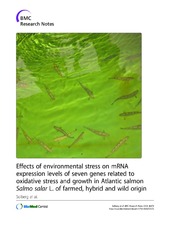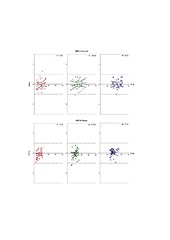| dc.contributor.author | Solberg, Monica F. | eng |
| dc.contributor.author | Kvamme, Bjørn Olav | eng |
| dc.contributor.author | Nilsen, Frank | eng |
| dc.contributor.author | Glover, Kevin | eng |
| dc.date.accessioned | 2013-05-30T09:32:06Z | |
| dc.date.available | 2013-05-30T09:32:06Z | |
| dc.date.issued | 2012-12-05 | eng |
| dc.Published | BMC Research Notes 2012, 5:672 | eng |
| dc.identifier.issn | 1756-0500 | en_US |
| dc.identifier.uri | http://hdl.handle.net/1956/6675 | |
| dc.description.abstract | Background: Ten generations of domestication selection has caused farmed Atlantic salmon Salmo salar L. to deviate from wild salmon in a range of traits. Each year hundreds of thousands of farmed salmon escape into the wild. Thus, interbreeding between farmed escapees and wild conspecifics represents a significant threat to the genetic integrity of wild salmon populations. In a previous study we demonstrated how domestication has inadvertently selected for reduced responsiveness to stress in farmed salmon. To complement that study, we have evaluated the expression of seven stress-related genes in head kidney of salmon of farmed, hybrid and wild origin exposed to environmentally induced stress. Results: In general, the crowding stressor used to induce environmental stress did not have a strong impact on mRNA expression levels of the seven genes, except for insulin-like growth factor-1 (IGF-1) that was downregulated in the stress treatment relative to the control treatment. mRNA expression levels of glutathione reductase (GR), Cu/Zn superoxide dismutase (Cu/Zn SOD), Mn superoxide dismutase (Mn SOD), glutathione peroxidase (GP) and IGF-1 were affected by genetic origin, thus expressed significantly different between the salmon of farmed, hybrid or wild origin. A positive relationship was detected between body size of wild salmon and mRNA expression level of the IGF-1 gene, in both environments. No such relationship was observed for the hybrid or farmed salmon. Conclusion: Farmed salmon in this study displayed significantly elevated mRNA levels of the IGF-1 gene relative to the wild salmon, in both treatments, while hybrids displayed a non additive pattern of inheritance. As IGF-1 mRNA levels are positively correlated to growth rate, the observed positive relationship between body size and IGF-1 mRNA levels detected in the wild but neither in the farmed nor the hybrid salmon, could indicate that growth selection has increased IGF-1 levels in farmed salmon to the extent that they may not be limiting growth rate. | en_US |
| dc.language.iso | eng | eng |
| dc.publisher | BioMed Central | en_US |
| dc.rights | Attribution CC BY | eng |
| dc.rights.uri | http://creativecommons.org/licenses/by/2.0/ | eng |
| dc.subject | Atlantic salmon | eng |
| dc.subject | Farmed escapees | eng |
| dc.subject | Introgression | eng |
| dc.subject | Common-garden | eng |
| dc.subject | mRNA leve | eng |
| dc.subject | Insulin-like growth factor | eng |
| dc.subject | Oxidative stress | eng |
| dc.subject | Non additive inheritance | eng |
| dc.title | Effects of environmental stress on mRNA expression levels of seven genes related to oxidative stress and growth in Atlantic salmon Salmo salar L. of farmed, hybrid and wild origin | en_US |
| dc.type | Peer reviewed | |
| dc.type | Journal article | |
| dc.description.version | publishedVersion | en_US |
| dc.rights.holder | Copyright 2012 Solberg et al.; licensee BioMed Central Ltd. | en_US |
| dc.identifier.doi | https://doi.org/10.1186/1756-0500-5-672 | |
| dc.identifier.cristin | 1003266 | |
| dc.source.journal | BMC Research Notes | |
| dc.source.40 | 5 | |




